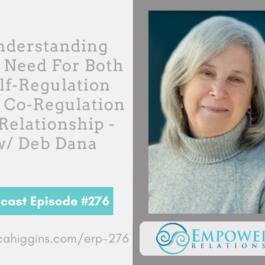
ERP 276: Understanding The Need For Both Self-Regulation And Co-Regulation In Relationship - An interview With Deb Dana
Self and co-regulation is an essential human need that couples need to understand to know that their relationship is somewhere they can feel safe and come home to. Deb Dana, LCSW, clinician and consultant specializing in Polyvagal theory, joins the podcast to discuss what regulation is, its role in the nervous system, and how couples can apply it to their relationships. Deb trains therapists worldwide on the Polyvagal approach. She is co-founder of The Polyvagal Institute and author of The Polyvagal Theory in Therapy: Engaging the Rhythm of Regulation and Polyvagal Exercises for Safety and Connection: 50 Client-Centered Practices. Deb is also the co-editor with Stephen Porges of Clinical Application of the Polyvagal Theory: The Emergence of Polyvagal Informed Therapies and developer of the Rythm of Regulation clinical training series among many other pioneering works into this space. Check out the transcript to this episode in Dr. Jessica Higgin's website. In this episode: 06:21 Co-regulation is the first organizing principle of polyvagal theory. It is a biological need to survive and to experience well-being. For people living with trauma, this did not happen in a safe environment and led to self-regulation instead. 08:40 Neuroception is the second organizing principle. It refers to the nervous system's way of getting information. The nervous system is constantly listening to three pathways: inside the body, the environment, and other nervous systems. 09:57 Hierarchy is the third organizing principle. There are three states that we visit all the time: ventral (safety and connection), sympathetic (fight and flight), and dorsal (disconnect and shutdown). 13:25 Co-dysregulation in relationship is common and when this happens the prefrontal cortex doesn't work the way it should. For couple therapy to be effective, one system must be anchored in ventral. 17:52 Protective strategies keep partners sympathetically charged. Since biology keeps nervous systems in this state, timing is important so that connection happens. Reaching by one partner while the other is in this state will result in pushback. 27:28 Tips for couples in dysregulated phases and using language other nervous systems can understand. 35:01 Asking who, what, where, when is an exercise to anchor to ventral and feel safe. 43:07 Contact Deb and learn more about the Polyvagal approach. Mentioned The Polyvagal Institute Website Rhythm of Regulation Website The Polyvagal Theory in Therapy: Engaging the Rhythm of Regulation (*Amazon book link) Polyvagal Exercises for Safety and Connection: 50 Client-Centered Practices (*Amazon book link) Polyvagal Flip Chart: Understanding the Science of Safety (*Amazon book link) Clinical Application of the Polyvagal Theory: The Emergence of Polyvagal Informed Therapies (*Amazon book link) Befriending Your Nervous System: Looking Through the Lens of Polyvagal Theory (*Amazon audiobook link) Anchored: How to Befriend Your Nervous System Using Polyvagal Theory (*Amazon book link) Connect with Dr. Jessica Higgins Facebook: facebook.com/EmpoweredRelationship Instagram: instagram.com/drjessicahiggins Podcast: drjessicahiggins.com/podcasts/ Pinterest: pinterest.com/EmpowerRelation LinkedIn: linkedin.com/in/drjessicahiggins Twitter: @DrJessHiggins Website: drjessicahiggins.com Email: jessica@drjessicahiggins.com If you have a topic you would like me to discuss, please contact me by clicking on the "Ask Dr. Jessica Higgins" button here. Thank you so much for your interest in improving your relationship. Also, I would so appreciate your honest rating and review. Please leave a review by clicking here. Thank you! *With Amazon Affiliate Links, I may earn a few cents from Amazon, if you purchase the book from this link.
From "Empowered Relationship Podcast: Your Relationship Resource And Guide"



Comments
Add comment Feedback